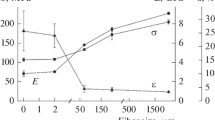Summary
The authors have subjected bonds of self-curing acrylic and human spongious bone to static tensile loading. In 110 tests using human femoral heads an average ultimate tensile strength of about 26 kp/cm2 was found.
Zusammenfassung
Es wird über Zugfestigkeitsuntersuchungen der Verbindung Spongiosa — PMMA berichtet. Bei Verwendung von menschlicher Femurkopfspongiosa wurde in 110 Versuchen eine durchschnittliche Bruchfestigkeit von etwa 26 kp/cm2 ermittelt.
Similar content being viewed by others
Literatur
Charnley, J.: Acrylic Cement in Orthopaedic Surgery. Edinburgh: E. & S. Livingstone 1970.
Oest, O.: Verbundosteosynthesen in mechanischer und funktioneller Sicht. Vortrag Jahrestagung der DGOT in Kiel, 1970.
Charnley, J., Kettlewell, J.: The Elimination of slip between prothesis and femur. J. Bone Jt Surg. 47 B, 56–60 (1965).
Wilson, J. N., Skales, J. T.: Loosening of total hip replacements with cement fixation. Clin. Orthop. 72, 145–160 (1970).
Kratzert, R., Schellmann, W.-D.: Verankerungsprobleme bei der Anwendung autopolymerisierender Kunststoffimplantate. Arch. orthop. Unfall-Chir. 68, 351–357 (1970).
McKee, G. K.: Development of total replacement of the hip. Clin. Orthop. 72, 85–103 (1970).
Mueller, M. E.: Totalendoprothesen am Hüftgelenk. (Sonderdruck der Protek AG.)
Charnley, J.: A biomechanical analysis of the use of cement to anchor the femoral head prosthesis. J. Bone Jt Surg. 47-B, 354–363 (1965).
Sedlin, E. D.: A rheological model for cortical bone. Acta orthop. scand., Suppl. 83 (1965).
Ascenzi, A., Bonucci, E., Checcucci, A.: Tensile Properties of Single Osteons, Studies using a Microwave Extensiometer. In: Studies on the Anatomy and Function of Bones and Joints. G. F. Evans (ed.). Berlin-Heidelberg-New York: Springer 1966.
Rauber, A.: Elastizität und Festigkeit der Knochen. Leipzig 1876.
Vinz, H.: Die Änderungen der Materialeigenschaften und der stofflichen Zusammensetzung des kompakten Knochengewebes im Laufe der Altersentwicklung. Nova Acta Leopoldina 35, Nr. 192 (1970).
Sonoda, T.: Studies on the strength for compression, tension and torsion of the human vertebral column. J. Kyoto Pref. Med. Univ. 71, 649–702 (1962). In: Strength of Biological Materials, Niroshi Yamada, M. D. Baltimore: Williams & Wilkins 1970.
Author information
Authors and Affiliations
Rights and permissions
About this article
Cite this article
Kölbel, R., Boenick, U. Mechanische Eigenschaften der Verbindung zwischen spongiösem Knochen mit Polymethylmethacrylat bei statischer Belastung. Arch orthop Unfall-Chir 73, 89–98 (1972). https://doi.org/10.1007/BF00419075
Received:
Issue Date:
DOI: https://doi.org/10.1007/BF00419075




